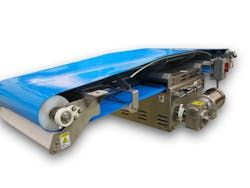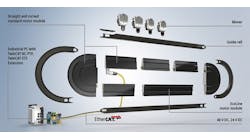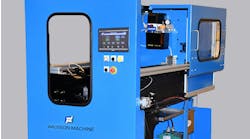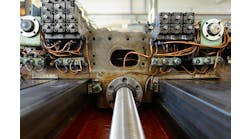Building the best conveyor and engineering the perfect production line are subjects Carmen Sammauro is happy to talk about. Sammauro is president at Eaglestone Equipment in St. Charles, Illinois, a design and manufacturing company specializing in producing equipment necessary for safe food processing and packaging.
Eaglestone stresses the importance of quality conveyors, and its product line spans from transfer conveyors and complete packaging lines to cryogenic tunnel freezers. "Conveyors are used for transfers, accumulation, product orientation, workstations and many other applications," states Sammauro. "All our equipment is used to aid in many processing applications and industries from food and pharmaceutical to the pet-food industry."
While Eaglestone's main focus is in the food-processing industry, it also designs and builds automation systems for non-food-related industries. The core controls are very similar in both industries, but, when designing for the food industry, the heavy wash-down environment must be considered.
Also read: How better control can pay off with improved machine efficiency
Eaglestone was started in 1990 by a group of ambitious young men who wanted to change the manufacturing industry. "We started out as a seven-man, family-run shop; there was one person in the office, and there were six people in the shop," states Sammauro. "We started out in a small, 7,000-sq-ft building located in Carol Stream, Illinois, and now we’re in St. Charles, occupying 30,000 sq ft and quickly outgrowing it."
Turnkey or bust
This conveyor addresses the cleanliness issues typically found in traditional troughed conveyors by creating a sanitary, open design.
Source: Eaglestone Equipment
"Over the years, Eaglestone has expanded its expertise from manufacturing one-off/single units to being a company that can handle the entire line, start to finish, without losing the small-company feel," notes Sammauro. "With our turnkey integration services, Eaglestone manages the complete layout, engineering and manufacturing of the production line." The ability to provide a turnkey custom conveyor system is a key advantage for Eaglestone or any custom conveyor manufacturer. Delivering a turnkey production line throughout a facility eliminates confusion between vendors.
"Eaglestone is still a family-run company that believes hard work, dedication, perseverance and excellent customer service are the keys to success in this world," states Sammauro. "We have big plans for the future and are always looking to expand our customer and product base, while fully dedicating ourselves to our current customers and products. We currently have about 40 employees, which include five mechanical engineers and one electrical engineer. We send our employees all over the country, and our equipment is shipped all over the world."
Eaglestone prides itself on delivering a complete package, and that includes after-sales support. "When our systems are delivered, they include equipment manuals, safety manuals, recommended spare parts, assembly instructions and drawings to aid in a smooth installation and operation of our equipment," says Sammauro. "We offer on-site factory acceptance test (FAT), customer site acceptance test (SAT) and training at our facility as well as at the customer’s. Web-based support has become more popular recently both in diagnosing control issues and 3D plant walkthroughs to confirm equipment fit."
During the needs assessment phase of the project, Eaglestone confirms the new equipment will fit in the facility using a high-accuracy Faro laser scanner to capture a 3D image of the plant. Existing machinery, conduit, piping and building structures are detailed in a 3D CAD model using the laser. The complete Web-based 3D plant view can be accessed by both Eaglestone engineers and the customers, helping to identify potential interference problems with existing equipment and traffic issues.
Conveyor control
Eaglestone's machine controls range from a simple single drive running a conveyor to full multi-drive network-based automation systems controlling a complete conveyor line. "The control architecture varies from project to project, depending on the complexity and project requirements," states Dave Locke, controls engineering manager at Eaglestone. "However, our larger multi-drive systems typically employ a network-based configuration. We strive to provide a system that fits the application and provides for future expansion, if required."
While Eaglestone's control systems are typically PLC-based, some of the larger systems are based off of PACs. "Our controls team has the ability to integrate and program a wide variety of controllers," notes Locke. "Other than meeting our customer's hardware requirements when selecting a control platform, our key requirements are flexibility and availability."
When tying together distributed drives, sensors and solenoids, Eaglestone uses Powerlink, EtherNet/IP and Modbus (RTU, TCP) network protocols. "An Ethernet physical layer with the related hardware has worked well for these control networks due to ease of use, scalability and remote VPN access," comments Locke. "If a drive has to be added, for example, I don’t want to be limited by the PLC and the number of network nodes it can handle."
Future conveyor-line control systems will likely change. "Our current safety system designs typically use safety relays and integrated safety drives," comments Locke. "However, we are currently looking at the cost-effectiveness of using safety controllers. Over the next several years, I would say that our controls will gravitate to manufacturers that provide a cost-effective integrated safety PLC."
Other technology trends may impact conveyor lines. "I see wireless providing an easy way to distribute I/O across a machine or especially a plant-wide conveyor line,” says Locke. “As is the case with all networks, the security aspect will require firewalled, secured and isolated machine-control networks for the best conveyor control."
I see wireless providing an easy way to distribute I/O across a machine or especially a plant-wide conveyor line.”







